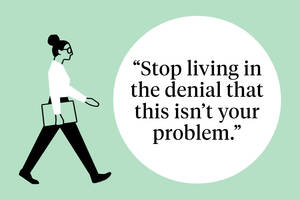To ease you and your children through the transition, we’ve compiled some of our favorite education research from Kellogg faculty.
1. Getting Your Kid into the Best Possible School Can Backfire
Your child didn’t get into the school of her (or your) dreams? There may be an upside.
Moving to a new, more elite institution comes with a shift in status. At their old school, they may have been at the top of their class; now, they might rank in the middle or bottom, even though their intelligence level has not changed.
Jörg Spenkuch, an associate professor of managerial economics and decision sciences, and coauthors found that this downgrading in academic rank can significantly increase the risk of academic and behavioral problems—indeed, exactly the types of issues parents were likely trying to avoid by changing schools.
The results come both from a mathematical model and real-world data.
In one study, the researchers analyzed data from Kenya where students from 60 primary schools were randomly assigned to new classes. With the shuffling, a high-ranking student might find herself lower on the totem pole in her new class, or vice versa.
The researchers compared the performance of kids with similar skill levels who ended up with different rankings. They found that an increase in class rank was linked to higher scores on standardized tests 18 months later.
“It seems to be good to be a big fish in a small pond,” Spenkuch says.
A second study tracked New York City public school students as they switched from elementary to middle school. Dropping in class rank appeared to make students act out more. If one kid fell from the 75th to 25th percentile upon entering middle school and another rose from the 25th to 75th percentile, the first student was more likely to have at least one record of misbehavior than the second student.
The researchers are not saying that high-achieving students should not move to better schools. With the positive changes that come from such a move, such as better teachers or newer facilities, “it might still be a good idea at the end of the day,” Spenkuch says. But parents should keep in mind that the transition also may bring some challenges.
2. Avoiding Too Many Choices
If teachers want to keep a student’s nose in a book, they may be better off giving them just two to three titles to choose from, rather than a hefty stack. That’s because offering children too many choices can lead them to spend less time engaged with the choice they ultimately make.
In this way, children aren’t so different from the rest of us.
Psychologists and marketers have found evidence that, among adults, having lots of choices can feel overwhelming or make us regretful of our final choice—a phenomenon known as “choice overload.”
Michal Maimaran, a clinical associate professor of marketing, wondered how an abundance of choice might affect children, particularly how much they actually engage with their final selection. After all, she says, “what matters most is, after you chose something, what do you do with it?”
In several studies, she showed that when kids pick from a large set of options, they spend less time engaged with their choice than when they pick from a small set.
In one study, for example, preschoolers were asked to select a book from a set of either two or seven Curious George titles. Maimaran found that children who picked between two books spent less time arriving at their choice and more time looking at the book compared with children who chose from among seven options.
In a similar experiment with sets of blocks, kids who picked from a set of two spent twice the time playing with the blocks compared with children who picked from among six options.
3. Helping First-Generation College Students
It’s back to school for college students, too. This transition can be particularly thorny for students who do not have college-educated parents. First-generation college students tend to lag behind their peers, in part because of the stress of adjusting to a culture they have little experience navigating.
But a single hour-long meeting could go a long way toward reversing that trend, according to research from Nicole Stephens, an associate professor of management and organizations, and colleagues.
More than a hundred students, some of whom were first-generation college-goers, attended a meeting that took place during the first few weeks of their freshman year. One group attended a meeting where seniors discussed their college experience in light of their social backgrounds, while another group attended a meeting where social background was never mentioned.
Two years later, each student was asked to give a short speech and perform a series of stressful tasks, including a GRE-style test and a word-search puzzle.
The results were clear: In their speeches, students who had attended the meeting where social class was discussed—regardless of their own social status—were more comfortable discussing their own background and its influence on their college lives. The first-generation participants in this group also showed more physiological thriving, as measured by changes in their neuroendocrine levels.
“It’s a self-reinforcing process,” Stephens says. “If you change how people are making sense of their experience at a transitional moment, you can change their behavior, and that in turn will influence how they experience their environment.”
4. Assessing STEM Degrees and Innovation
Push more students into STEM (science, technology, engineering, or math) degree programs and the economy will boom—right? After all, graduating with a STEM degree leads to better job prospects. Surely boosts in innovation and long-term economic growth will follow.
But a Kellogg study suggests that an increase in STEM graduates does not always have a positive effect on innovation.
Nicola Bianchi, an assistant professor of strategy, collected data on Italian high school students who—as a result of a 1961 educational reform—suddenly had access to new educational opportunities at the university level. By tracking these students’ subsequent patent records and comparing them with those of similar students who graduated before 1961, Bianchi and a colleague were able to tell what university education actually did for innovation.
They found that, surprisingly, the most talented STEM high school students actually patented much less after getting access to STEM majors then they had done before.
A STEM education, it turned out, opened up opportunities for these students beyond occupations that tend to produce patents. “Getting a STEM degree made these people eligible for other types of jobs,” Bianchi says, “and they took them.”
Of course, Italy in the 1970s is quite different from the United States today. But Bianchi believes that at least one lesson from Italy’s experience is generalizable: some economic sectors produce more patents than others. And people with STEM degrees have skills that are in demand by multiple sectors—including those that don’t produce many patents. Think of the brilliant physics students and computer scientists who get lured away by lucrative jobs in finance.
“The relationship between scientific education and innovation is tricky,” he says.




